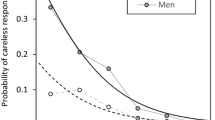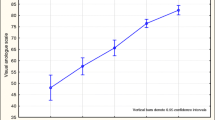Abstract
Clinicians and researchers have become increasingly interested in the impact of chronic pain (CP) on quality of life (QoL). This report describes the qualitative stages of developing a pain and discomfort module for persons with CP to be used with the UK World Health Organisation generic measure of quality of life (WHOQOL). The aims were to investigate patients' perceptions of CP and its effect on QoL, and to generate items to be used in the development of a module appended to the UK WHOQOL-100. At the first stage (study 1), six focus groups of patients were invited to discuss how living with pain and discomfort affected QoL. At the second stage (study 2), an international web survey was conducted with English-speaking respondents. 10 new facets of QoL were identified by the focus groups: flare-ups, pain relief, anger and frustration, vulnerability/fear/worry, uncertainty, loss/loneliness/feeling alone, positive strategies, communication, guilt and burdening others, and relationship with health-care providers. The web-survey confirmed and validated these new facets. Although the WHOQOL-100 is a reliable and valid measure of QoL for use in CP, this study shows that additional areas must be assessed when measuring the impact of CP on QoL.
Similar content being viewed by others
References
Fallowfield L. The Quality of Life: The Missing Measurement in Health Care. London: Souvenir Press, 1990.
Detmar SB, Muller MJ, Schornagel JH, et al. Role of health-related quality of life in palliative chemotherapy treatment decisions. J Clin Oncol 2002; 20: 1056-1062.
Cohen I, Rainville J. Aggressive exercise as treatment for chronic low back pain. Sports Med 2002; 32: 75-82.
Saunders C, Egger M, Donovan J, et al. Reporting on quality of life in randomised control trials: Bibliographic study. BMJ 1998; 317: 1191-1194.
Muldoon MF, Barger SD, Flory JD, Manuck SB. What are quality of life measurements measuring? Br Med J 1998; 316: 542-545.
Schappert SM. National Ambulatory Medical Care Survey: 1989 summary. National Center for Health Statistics. Vital Health Stat 13 1992; No. 110.
Gureje O, Von Korff M, Simon GE, Gater R. Persistent Pain and Well-being: A World Health Organisation Study in Primary Care. JAMA 1998; 280: 147-151.
Aronoff GM. Chronic pain and the disability epidemic. Clin J Pain 1991; 7: 330-338.
Loeser JD. What is chronic pain? Theor Med 1991; 12: 213-225.
The WHOQOL Group. The World Health Organisation Quality of Life Assessment (the WHOQOL): Position paper from the World Health Organisation. Soc Sci Med 1995; 41: 1403-1409.
The WHOQOL Group. The WHOQOL: Development and general psychometric properties. Soc Sci Med 1998; 46: 1569-1585.
Skevington SM. Investigating the relationship between pain and discomfort and quality of life using the WHOQOL. Pain 1998; 76: 395-406.
Skevington SM, Carse MS, Williams AC. Validation of the WHOQOL-100: Pain management improves quality of life for chronic pain patients. Clin J Pain 2001; 17: 264-275.
Dunn V. The holistic assessment of the patient in pain. Prof Nurse 2000; 15: 791-793.
Turk DC, Okifuji, A. Pain: Assessment of patients' reporting of pain: An integrated perspective. Lancet 1999; 353: 1784-1788.
Maniadakis N, Gray A. The economic burden of back pain in the UK. Pain 2000; 84: 95-103.
BBC News. UK Internet usage surges. Jupiter MMXI. 2001. Available at http://news.bbc.co.uk/1/hi/business/ 1500668.stm. Accessed 12-12-2002.
Chan C, Bumatay M, Shandwick W, Pileggi S. Internet usage climbs to a record height in October. Nielsen Net Ratings. 2001. Available at http://www.nielsen-netratings. com/pr/pr_011113.pdf. Accessed 12-12-2002.
NUA. How many online? NUA. 2002. Available at http:// www.nua.ie/surveys/how_many_online/index.html. Accessed 12-12-2002.
Taylor MR, Alman A, Manchester DK. Use of the Internet by patients and their families to obtain genetics-related information. Mayo Clin Proc 2001; 76: 769-771.
Bliven BD, Kaufman SE, Spertus JA. Electronic collection of health related quality of life data: Validity, time benefits and patient preference. Qual Life Res 2001; 10: 15-22.
Elliott AM, Smith BH, Penny KI, et al. The epidemiology of chronic pain in the community. Lancet 1999; 354: 1248-1252.
International Association for the Study of Pain and Subcommittee on Taxonomy. Classification of chronic pain. Pain 1986; (Suppl 3).
Mays N, Pope C. Rigour in qualitative research. BMJ 1995; 311: 109-112.
Kuzel AJ. Sampling in qualitative inquiry. In: Crabtree BF, Miller WL (eds), Doing Qualitative Research. London: Sage, 1992; 31-44.
Skevington SM. Measuring quality of life in Britain: Introducing the WHOQOL-100. J Psychosom Res 1999; 47: 449-459.
Skevington SM, MacArthur P, Somerset M. Developing items for the WHOQOL: An investigation of contemporary beliefs about quality of life related to health in Britain. Br J Health Psychol 1997; 2: 55-72.
Morgan DL. Focus groups as a qualitative research. Sage University Paper Series on Qualitative Research Methods. Beverly Hills, California: Sage, 1988.
Morgan DL, Kreuger RA. The Focus Group Kit. Beverly Hills, California: Sage Publications, 1998.
Melzack, R. The McGill Pain questionnaire: Major properties and scoring methods. Pain 1975; 7: 277-299.
Whitney CW, Von Korff M. Regression to the mean in treated versus untreated chronic pain. Pain 1992; 50: 281-285.
Hammond A, Freeman K. One-year outcomes of a randomized controlled trial of an educational-behavioural joint protection programme for people with rheumatoid arthritis. Rheumatology (Oxford) 2001; 40: 1044-1051.
Jensen MP, Karoly P, Huger R. The development and preliminary validation of an instrument to assess patients' attitudes toward pain. J Psychosom Res 1987; 31: 393-400.
Harkapaa K, Jarvikoski A, Mellin G, et al. Health locus of control beliefs and psychological distress as predictors for treatment outcome in low-back pain patients: Results of a 3-month follow-up of a controlled intervention study. Pain 1991; 46: 35-41.
Fernandez E, Turk DC. The scope and significance of anger in the experience of chronic pain. Pain 1995; 61: 165-175.
Symonds TL, Burton AK, Tillotson KM, Main CJ. Absence resulting from low back trouble can be reduced by psychosocial intervention at the work place. Spine 1995; 20: 2738-2745.
George SZ, Fritz JM, Erhard RE. A comparison of fear-avoidance beliefs in patients with lumbar spine pain and cervical spine pain. Spine 2001; 26: 2139-2145.
Cohen I, Rainville J. Aggressive exercise as treatment for chronic low back pain. Sports Med 2002; 32: 75-82.
Thomas SP. A phenomenologic study of chronic pain. West J Nurs Res 2000; 22: 683-699.
Snelling J. The effect of chronic pain on the family unit. J Adv Nurs 1994; 19: 543-551.
Sodergren, SC, Hyland ME. What are the positive consequences of illness? Psychol Health 2000; 15: 85-97.
Sodergren SC, Hyland ME, Singh SJ, Sewell L. The effect of rehabilitation on positive interpretations of illness. Psychol Health 2002; 17(6): 753-760.
Folkman S. Positive psychological states and coping with severe stress. Soc Sci Med 1997; 45: 1207-1221.
Loeser JD. Economic implications of pain management. Acta Anaesthesiol Scand 1999; 43: 957-959.
Maetzel A, Li L. The economic burden of low back pain: A review of studies published between 1996 and 2001. Best Pract Res Clin Rheumatol 2002; 16: 23-30.
Author information
Authors and Affiliations
Rights and permissions
About this article
Cite this article
Mason, V.L., Skevington, S.M. & Osborn, M. Development of a Pain and Discomfort Module for Use with the WHOQOL-100. Qual Life Res 13, 1139–1152 (2004). https://doi.org/10.1023/B:QURE.0000031344.53009.eb
Issue Date:
DOI: https://doi.org/10.1023/B:QURE.0000031344.53009.eb




